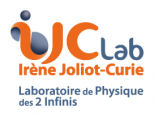
Energy flux of ultra-high energy cosmic rays at the Earth as a function of energy. The spectrum of all particles and the proton component are represented by black circles and red squares, respectively. The lighter points are not included in the fit. The sub components obtained for four detected mass groups are represented by solid colored lines.
The Astrophysical Journal publishes on 2022-09-01 an article led by Quentin Luce (KIT, Germany) and Sullivan Marafico (IJCLab), with contributions from Jonathan Biteau (IJCLab), Antonio Condorelli (IJCLab) and Olivier Deligny (IJCLab). This publication provides the first joint description of the proton component below the ankle energy, at ~5 EeV, and that of heavier nuclei at higher energies. Assuming an evolution of the sources following that of the matter contained in the stars, the authors show in particular that the protons emitted by the astrophysical sources should present a softer spectrum than their heavier counterparts. The confirmation of such an evolution would provide observational evidence of interactions within the sources, shaping the spectra of the ultra-high energy cosmic rays that escape from them.
Abstract
Interactions of ultra-high energy cosmic rays (UHECRs) accelerated in specific astrophysical environments have been shown to shape the energy production rate of nuclei differently from that of the secondary neutrons escaping from the confinement zone. Here, we aim at testing a generic scenario of in-source interactions through a phenomenological modeling of the flux and composition of UHECRs. We fit a model in which nucleons and nuclei follow different particle energy distributions to the all-particle energy spectrum, proton spectrum below the ankle energy and distributions of maximum shower depths above this energy, as inferred at the Pierre Auger Observatory. We obtain that the data can be reproduced using a spatial distribution of sources that follows the density of extragalactic matter on both local and large scales, providing hence a realistic set of constraints for the emission mechanisms in cosmic accelerators, for their energetics and for the abundances of elements at escape from their environments. While the quasi mono-elemental increase of the cosmic-ray mass number observed on Earth from ~2 EeV up to the highest energies calls for nuclei accelerated with a hard spectral index, the inferred flux of protons down to ~0.6 EeV is shown to require for this population a spectral index significantly softer than that generally obtained up to now. We demonstrate that modeling UHECR data across the ankle substantiate the conjecture of in-source interactions in a robust statistical framework, although pushing the mechanism to the extreme.









